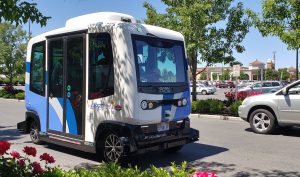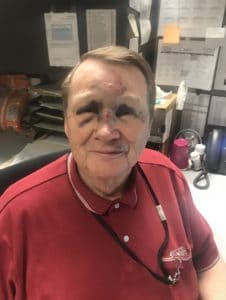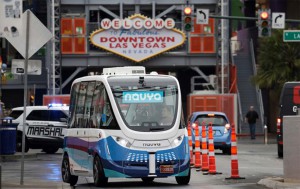
Utah is testing self-driving shuttle buses. A state employee suffered injuries in one when it stopped suddenly.
A 76-year-old passenger riding in an autonomous shuttle has been injured after the vehicle came to an unexpected stop, according to multiple media reports.
Gene Petrie, an employee of the Utah State Tax Commission, was thrown from his seat and hit the handrail near the door, resulting in bruising and black eyes. Charlie Roberts, spokesman for the Utah State Tax Commission, said: “Out of the clear blue, it suddenly stopped, and it wasn’t a slow-down stop. It was a sudden stop.”
Petrie went to the hospital for treatment and returned to work the next day. He was traveling on the shuttle near the Multi Agency State Office Building in Salt Lake City where the Utah Department of Transportation is testing the technology. The department has been testing the shuttles since April and this is the first reported incident.
(Over 70% of Americans “Afraid” to Ride in a Fully Autonomous Vehicle)
However, it’s not the only injury sustained during the testing of the slow-moving shuttle buses. A woman in Vienna, Austria, sustained a knee injury when she was struck by a Navy SAS shuttle moving at 7.5 mph. It was a Navya shuttle that was hit by a truck during its debut in Las Vegas about 18 months ago. There were no injuries, but it highlighted the limitations of driverless vehicles — if the shuttle had backed up or moved over, it may have avoided the collision.
Additionally, self-driving vehicles have been involved in a number of crashes resulting in injuries and deaths. Four people have died while their vehicles engaged in some form of autonomous driving. Perhaps none more noteworthy than the death of Elaine Herzberg, who was crossing a road at night outside Phoenix when she was struck and killed by a Volvo using Uber’s self-driving technology.

Gene Petrie, 76, suffered two black eyes when the shuttle stopped without warning. (Photo credit: Utah State Tax Commission)
However, the promise that the technology holds continues to drive development. An estimated 94% of all automotive crashes are caused by human error, and tens of thousands of people are killed annually in traffic accidents. Utah is one of many states that allows the testing of self-driving vehicles.
“As soon as this happened, we took the shuttle out of service immediately for about 24 hours and ran a bunch of tests on it, ran through the emergency stops, looked at the software, looked at the sensors,” said John Gleason, UDoT spokesman.
The cause of the sudden stop remains unknown as no one noticed a pedestrian or obstacle that may have tripped a sensor.
(Driverless Shuttle Crashes During Public Debut in Las Vegas)
“You hate to see an incident like that, but we’re confident in the overall safety of the shuttle and we’ve taken a lot of precautions to ensure something like this doesn’t happen again,” Gleason adds.
The UDoT reduced the shuttle’s speed from 12 to 9 mph. The operator is now more frequently warning people that abrupt stops are possible, according to media reports.
The Utah Department of Transportation began testing the shuttle in April and it follows a fixed route around the department’s office building. The vehicle was legally able to operate on Utah roads after state lawmakers approved a bill allowing testing of the shuttle to move from a closed track to sidewalks and state roads.
The design of the automated shuttle includes a place for a safety driver who is on board to monitor the vehicles performance without actually driving the vehicle. The vehicle, which is very similar to one tested at the University of Michigan in Ann Arbor, Michigan, last year, is designed to carry passenger, who sit or stand, depending on the space available.

Initially, the shuttles, built by Navya, were used autonomously, but they began operating completely without a driver this week.
Utah officials hope the use of shuttles can eventually reduce congestion in the fast-growing state and reduce traffic deaths.
Despite a handful of mishaps where vehicles using automated systems have been involved in fatal crashes, regulators and automakers insist the biggest benefit of self-driving vehicles are potential to reduce the number of deadly crashes to zero or nearly zero.
(Congress Ready to Consider Autonomous Vehicle Legislation)
Last year, traffic accidents claimed the lives of more 37,000 people in the United States and more than 1 million victims worldwide, according to the best available statistics.

Should have been wearing a seat belt.
The word “seat belt” wasn’t even mentioned.
Notice the media focuses on the AV’s misstep and not the fact the passenger chose to not wear a seatbelt? Stories like this fuel the public’s fear of AVs.
How many people wear seatbelts in shuttle buses or regular buses, especially slow-speed buses.
You’ll notice that there is a line in the story that the gentleman was warned that AV could stop abruptly, yet he elected to not wear a seatbelt. Stories like this do not fuel the public’s fear of AVs. Folks have been riding in slow-moving shuttles since large-scale amusement parks have been open.
Stories about hackers taking over a vehicle and running it into a ditch or driving it off course, those help “fuel” fears about AVs.